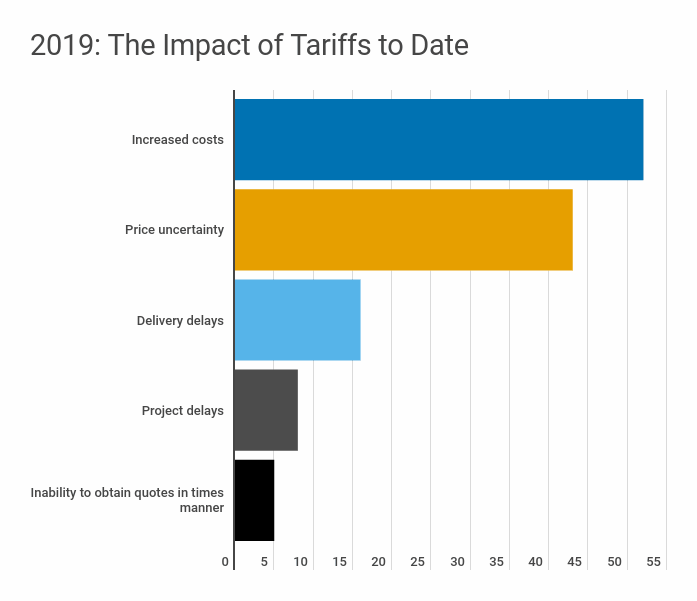
Anecdotally, many would say that steel tariffs have had an impact on their business in 2019. But what are the specifics? According to a recent survey of Ryerson customers, the impact has been a mixture of price increases and overall project uncertainties.
The second edition of Ryerson’s customer survey, The Metal Perspective, gathered insight from manufacturers, fabricators, and machine shops on a range of market-specific and macro-economic conditions. When asked how tariffs have impacted business thus far in 2019, the top-three responses were as follows: increased costs (52 percent), price uncertainty (43 percent), and delivery delays (16 percent).
This supports data from the first edition (which surveyed customers at the end of 2018) in which roughly 55 percent of respondents anticipated that tariffs would be a primary business concern for them in 2019.
However, not all respondents believe the 25 percent tariffs on steel and 10 percent on aluminum imports imposed by the Trump Administration in early 2018 are a major factor. Roughly 21 percent said they haven’t seen an impact on business this year, while another 16 percent were uncertain as to the specific impact of tariffs in 2019.
(Source: The Metal Perspective, a Ryerson customer survey. Multiple responses applied.)
Market data supports the notion that steel tariffs, among other factors, are impacting the global steel industry. A report released on August 23 from the American Iron and Steel Institute, based on preliminary Census Bureau data, showed that the U.S. imported a total of 3,028,000 net tons (NT) of steel in July 2019, including 1,843,000 NT of finished steel. The numbers were up 48.3 percent and 6.6 percent, respectively, vs. June final data.
While the numbers are increased from the prior month, the report found that total and finished steel imports through the first seven months of 2019 are 18,666,000 and 13,536,000 NT, down 10.6 percent and 16.4 percent respectively from the same period in 2018.
As we head into the final four months of 2019, tariffs and trade uncertainty should continue to be among the driving factors in the global steel market. For example, a report from George Mason University's Mercatus Center sheds some interesting light on trade turbulence between the U.S. and China and its impact on the steel market.
According to data compiled on product exclusion requests associated with the Section 301 tariffs as of July 30, 2019, the report found that the White House has granted more product exclusions requests on tariffs for aluminum and steel than those on China tariffs.
According to Mercatus Center, while 23 percent of tranche one and two of the 301 tariffs have been approved (26 percent and 10 percent for tranche one and two, respectively), 49 percent of steel tariff exclusion requests and 50 percent of aluminum tariff exclusion requests have been approved.
Stay on top of what moving the market with such resources as Material Movers and the Monthly Market Report from Ryerson.



.ashx?h=300&w=940&hash=4912CD78AEE8709AE78647BF6479A9C9)
.ashx?h=300&w=940&hash=71E0E1C301D05C446BAA7B69C09DBA49)